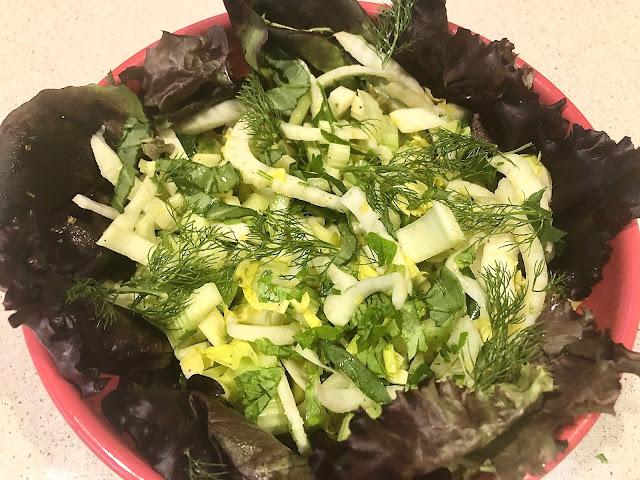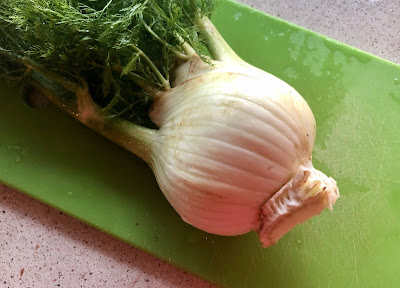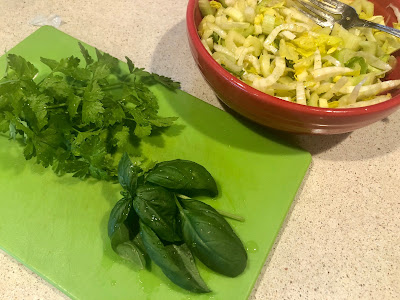
Recipe: Fennel pairs with celery hearts for a crunchy side dish
 |
|
Dressed and ready to serve, this salad is crunchy and flavorful. (Photos: Kathy
Morrison)
|
The fennel had to go, there was no question. I had plopped it into a corner of a raised bed last fall when I changed plots at my community garden. But now it was HUGE -- not to mention in the way of the spot where I wanted to put my Sweet Chelsea cherry tomato. And everything I've read says fennel is an anti-companion plant to tomatoes.
So the Giant Fennel of Carmichael was pulled up, and some of it went into a delicious salad. We had it alongside chicken, but it would be absolutely perfect with grilled salmon, if you're so inclined.
Note: As with any salad, the ingredients can be varied to one's taste. The New York Times recipe this is generally based on included radishes, radicchio and slivers of Parmesan, all of which I chose to omit for various reasons. I used about half the dressing, so there would be plenty if you decide to double the salad ingredients.
 |
|
This is the fennel I used in the salad. It was less than one-third
the entire plant I pulled out.
|
Fennel-celery salad with lemon and herbs
Serves 2-4
Ingredients:
Dressing:
3 tablespoons fresh lemon juice plus 1 teaspoon lemon zest (from 1 or 2 lemons)
1 or 2 garlic cloves, smashed but left mostly intact
Freshly ground pepper
Kosher salt
1/4 cup extra virgin olive oil
Salad:
1 medium fennel bulb, trimmed and thinly sliced (save some of the most tender fronds for garnish)
1 celery heart, inner stalks and leaves, thinly sliced (at least 1 cup)
Handful of snow pea pods, optional, halved
1 to 2 tablespoons fresh parsley, chopped
Several basil leaves, thinly sliced
Baby greens, all one kind or a mix, for serving
Garnish:
Reserved tender fronds from the fennel
 |
|
The parsley came from my garden, the basil from a plant I just
bought a few days ago. (It won't miss those leaves.)
|
Instructions:
Put the lemon juice, zest and garlic clove(s) in a jar or small bowl. Add a pinch of salt and pepper, then whisk in the olive oil (a small fork works great for this in a jar). Set dressing aside for at least 10 minutes.
To make the salad, put the sliced fennel, celery and snow peas (if using) in a salad bowl. Season lightly with salt and pepper.
Remove the garlic from the dressing, and whisk the dressing again to combine. Pour over the vegetables and toss. Sprinkle the parsley and the basil over the vegetables, stir in, and taste, then adjust the seasonings.
Line the edge of the bowl with the baby greens. Sprinkle the fennel fronds over the salad and serve.
Comments
0 comments have been posted.Sacramento Digs Gardening to your inbox.
Food in My Back Yard Series
April 1: Don't be fooled by these garden myths
March 25: Fertilizer tips: How to 'feed' your vegetables for healthy growth
March 18: Time to give vegetable seedlings some more space
March 11: Ways to win the fight against weeds
March 4: Potatoes from the garden
Feb. 25: Plant a fruit tree now -- for later
Feb. 18: How to squeeze more food into less space
Feb. 11: When to plant? Consider staggering your transplants
Feb. 4: Starting in seed starting
Sites We Like
Garden Checklist for week of March 30
Your garden doesn’t mind April showers. Get busy now to enjoy those future flowers.
* Get ready to swing into action in the vegetable garden. As nights warm up over 50 degrees, start setting out tomato, pepper and eggplant transplants.
* From seed, plant beans, beets, cantaloupes, carrots, corn, cucumbers, melons, pumpkins, radishes and squash. (Soak beet seeds overnight in water for better germination,)
* Plant onion sets.
* In the flower garden, plant seeds for asters, cosmos, celosia, marigolds, salvia, sunflowers and zinnias.
* Transplant petunias, zinnias, geraniums and other summer bloomers.
* Plant perennials and dahlia tubers for summer bloom.
* Transplant lettuce and cabbage seedlings.
* April is the last chance to plant citrus trees such as dwarf orange, lemon and kumquat. These trees also look good in landscaping and provide fresh fruit in winter.
* Smell orange blossoms? Feed citrus trees with a low dose of balanced fertilizer (such as 10-10-10) during bloom to help set fruit. Keep an eye out for ants.
* Apply slow-release fertilizer to the lawn.